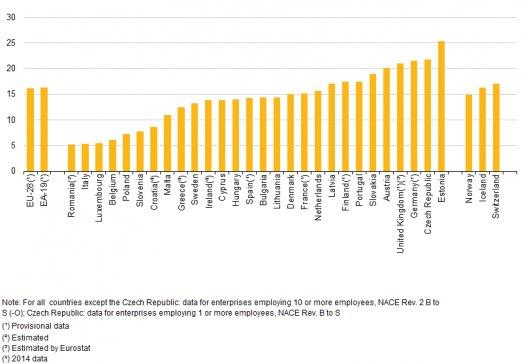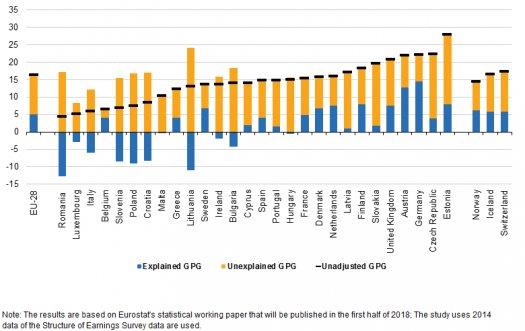 On the occasion of the International Women’s Day, Eurostat gave us a news that puts us in a very positive light at the level of the European Union:
On the occasion of the International Women’s Day, Eurostat gave us a news that puts us in a very positive light at the level of the European Union:
Romania is the European champion of gender equality in the labour market, with a pay gap of only 5.2% between men and women compared to a European average of 16.3%.
At a closer look, the situation appears more nuanced, but this singular performance remains statistically valid.
Inequality pay chart:
 If a breakdown is made by age groups of the employed population, it can be noticed that there is almost no payment difference between Romanian women and men under the age of 35.
If a breakdown is made by age groups of the employed population, it can be noticed that there is almost no payment difference between Romanian women and men under the age of 35.
With a colourful detail that the gap appears slightly in favour of women under the age of 25 who gets a job, which suggests even a slight ascendant position of them under similar conditions.
*
- Gender inequalities on the labour market in Romania by age groups (pay gap between men and women, %, 2016)
- Age group below 25
- Pay inequality
*
Thereafter, the difference increases to a modest 6.7% during the time when a part of the women is more intensively involved in children care, then decreases to the retirement age (of men, because women benefit from a lower pension age).
Incidentally, women also have a shorter legally required contributory period, therefore, receive a higher pension than men for the same score registered for the work done (the total score is divided by the number of years in the contribution period, 35 years for men, but 30 years for women). In other words, given the higher life expectancy and the longer time during which they receive payments, we can say that in fact, in Romanian women’s case, we are dealing with a „positive discrimination”.
Adjustment to be, but we should know too
However, let us see what happens when the gross indicators used by Eurostat have been analysed and adjusted. This is because it is only normal to be considered not only the monthly amount received but also the employment characteristics, which implies a weighting by the latter. Here, the data collected at the European level reveals the explainable part of the extra amount received and the inexplicable part (the one that, in fact, would be the source of the gender inequality).
Payment adjustment chart – Men and Women:
 Essentially, what the Eurostat chart intends to show is that, at the EU level, a woman is expected to earn 5.1% less than a man. The explainable part ranges from -12.7% in Romania to + 14.5% in Germany. The negative value in Romania means that in our country a woman, based on its specific characteristics, is expected to earn 12.7% more than a man, that is, a labour market favourable to women, while in Germany, we have exactly the opposite situation.
Essentially, what the Eurostat chart intends to show is that, at the EU level, a woman is expected to earn 5.1% less than a man. The explainable part ranges from -12.7% in Romania to + 14.5% in Germany. The negative value in Romania means that in our country a woman, based on its specific characteristics, is expected to earn 12.7% more than a man, that is, a labour market favourable to women, while in Germany, we have exactly the opposite situation.
The situation in our country, with a negative spread (namely, in favour of women), also occurs in ten other countries (including six former socialist countries- Bulgaria, Croatia, Hungary, Poland, Lithuania and Slovenia and four other countries – Italy, Ireland, Luxembourg and Malta). On the north-south and capitalism – former socialism axes, the situation changes radically, and the best example is the situation in the Baltic countries.
The unexplained part, which stands at 11.5% at the EU level of the 16.6% gender gap in the labour market, shows that a man doing exactly the same job earns on average by 11.5% compared to a woman. This part ranges between 2.5% in Belgium and 24.2% in Lithuania, with Romania placed somewhere at 17% (similar level to Bulgaria, Hungary, Croatia or Slovenia) and well above the European average.
It is worth noticing how Germany and Austria are overcome in terms of gender inequalities overall, by Estonia and the Czech Republic, precisely because of this type of gender discrepancy, with values comparable to those in Romania (with lower pay for women for the same work done). To which, in their case, it is also added the effect of the „westernised” structure of the labour market.
All in all, from two opposite effects, one regarding the structure of the labour market favourable to women (of course, through the characteristics specific to them in the current occupational context) and the other regarding the discrimination by lower payment for exactly the same work, Romania came out victorious among the EU countries (where Germany has less than 9% of such gender discrimination).
Perhaps the situation should be considered more specifically by the decision-makers, possibly before the labour market will „westernise”.
Perhaps we should better harmonize with the situation in more developed countries (including in terms of pensions, which should be granted based on merit, not „as a compensation”) and with some economic successes confirmed over time. Countries compared to which we manage to be, even when we rank miraculously first in the Eurostat rankings, just the opposite.










